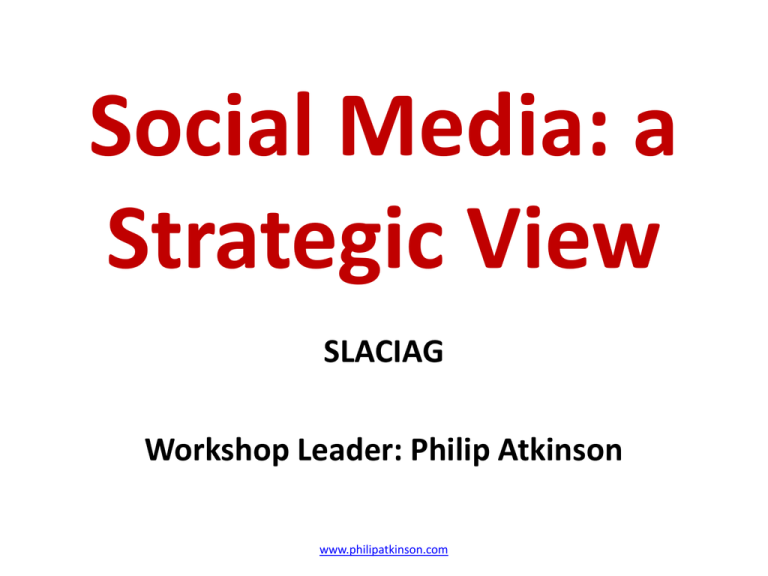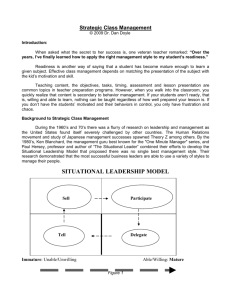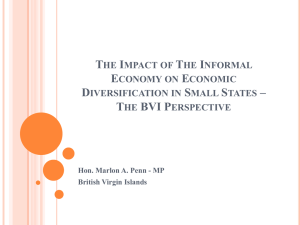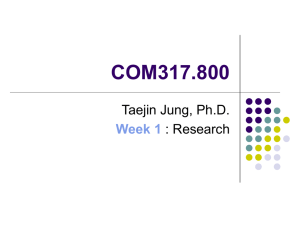Social Media Presentation
advertisement

Social Media: a Strategic View SLACIAG Workshop Leader: Philip Atkinson www.philipatkinson.com Objectives • Explore SM trends and how it impacts the role of Internal Audit • Summarise Q’re Response • Assess attitudes and risk appetites to SM • Is SM and Cultural audit an issue for HIA? • How can SLACIAG harness the benefits of SM? www.philipatkinson.com Generational Attitude to SM • • • • Baby Boomers (46-64) Generation X (60-82) Generation Y (83-20) Millennials – Echo Boomers (98 – Philip’s article on Millennials http://tinyurl.com/bnb7y7b www.philipatkinson.com Demographics Baby Boomers Generation X Politics & Economy Societal Values Dominant Events Core Values Role of Family Cultural Norms Education www.philipatkinson.com Generation Y Managing Expectations Risk Appetite - Generational • Users of SM: trust and are most adept at using SM • Staff Input • End Users or Recipients: • Regulators www.philipatkinson.com What is being said about you? Reactive Proactive High Control Low Control www.philipatkinson.com What is being said about you? High Control Website response Customer Response FaceBook Fan Page Facebook Twitter Open Forums Blogs Viral Social Media Youtube Non moderated Blog Company You Tube Linkedin Groups Low Control www.philipatkinson.com Reactive Proactive On site Reviews Online Videos Company Blog Managed Twitter Developing Social Media Define Policies Develop Action Plan Design Learning Resolve Issues Generate Awareness www.philipatkinson.com The Questions • Assess attitudes and risk appetites to SM • Is SM an issue for HIA? • How can SLACIAG harness the benefits of SM? www.philipatkinson.com Developing Social Media Stage 1: Define Principles & Policies 1. Why do we need Principles and policies to guide ‘social media 2. What factors need to be considered in their design? 3. Where does responsibility reside? 4. Where does IA fit? www.philipatkinson.com Contingencies in SM Policy Design • • • • • How it fits with Existing Policies Is Culture an issue Generational issues: Risk Profile & Appetite User Permissions Legal www.philipatkinson.com Contingent Factors in Policy Design Stages of Maturity 1. Immature 2. Informal 3. Develop Awareness 4. Positive Client Focused 5. Mastery Strategy for SM a. No Strategy b. Few projects c. Few Champions a. Reactive – little planning b. Fearful & unaware of positive ROI a. High level only b. Key platform presence c. SM integrated a. Agreed b. Integrated & ROI defined c. Explore Opps a. Aligned with Corporate b. SM channels defined Principles & Policies a. Unstructured b. Confused c. No ownership a. Informal processes b. Risk unaware c. Evolving Comms a. SM centralised b. SM L&D c. High awareness a. Policies agreed b. Cross organisation c. Open & dynamic a. Integrate SM & Comms goals b. 100% awareness Measure & Promote a. Awareness poor b. No metrics c. Little engagement a. Analytics poor b. Monitoring reactive c. Confused users a. Monitoring software b. Focused metrics a. All SM/CRM metrics captured b. Feedback from users a. Quality SM metrics b. Feedback to strategy c. Drives change Platforms & Tools a. Little Understanding b. Few applications a. Popular platforms b. One way c. Listen a. Integrated SM presence b. Platforms linked a. Tailored tools b. Data capture 100% c. Seamless service a. Open secure access b. Advanced tools using variety media Culture & Change Process a. No SM resource b. Confused users a. Individual SM evolution b. Loose ownership c. Erratic a. Awareness across the organisation b. Authoritative voice a. SM best practices & high participation b. Constant content flow a. Transparent feedback b. All users c. Dynamic & engaged www.philipatkinson.com Lets vote. But first, a quick test question… www.philipatkinson.com You have just reversed into your Audit Committee Chair's car in the car park, what do you do? 1. Drive off and hope no one has seen you 22% 2. Claim someone else did a hit and run! 9% 3. Own up and face the music 65% 4. Phone in sick 4% www.philipatkinson.com Contingent Factors in Policy Design What stage of maturity is your organisation's... Strategy for Social Media? 1. 2. 3. 4. 5. Immature Informal Develop Awareness Positive Client Focused Mastery www.philipatkinson.com 13% 17% 65% 4% 0% Contingent Factors in Policy Design What stage of maturity is your organisation's... Principles & Policies? 1. 2. 3. 4. 5. Immature Informal Develop Awareness Positive Client Focused Mastery www.philipatkinson.com 0% 30% 48% 22% 0% Contingent Factors in Policy Design What stage of maturity is your organisation's... Measure & Promote? 1. 2. 3. 4. 5. Immature Informal Develop Awareness Positive Client Focused Mastery www.philipatkinson.com 0% 52% 43% 4% 0% Contingent Factors in Policy Design What stage of maturity is your organisation's... Platforms & Tools? 1. 2. 3. 4. 5. Immature Informal Develop Awareness Positive Client Focused Mastery www.philipatkinson.com 9% 48% 35% 4% 4% Contingent Factors in Policy Design What stage of maturity is your organisation's... Culture & Change Process? 1. 2. 3. 4. 5. Immature Informal Develop Awareness Positive Client Focused Mastery www.philipatkinson.com 0% 61% 39% 0% 0% Issue Management 1. Immature 2. Informal 3. Develop Awareness 4. Positive Client Focused 5. Mastery Lack defined Strategy Absence from SM Ext Relations use only Cross functional KPI’s agreed SM strategy is the driver Drives Value Little Training Guidance None Generic Company Specific Site & Goal Specific Company & Goal specific Drives Value Shared password Unique account Secure Passwords Vault storage Password Standards applied Unaware of access Prohibition thru technology Allowed and tracked SM feedback integrated into business Monitoring public domains SM Managed No value No use of data captured Proactive Listening Automated listening Aligns with strategy and risk mitigation Strategic Monitoring Ignorance of SM No value in engaging Value aware but no action SM Outbound messaging SM – active two way dialogue SM valued as a business tool SM Expert Centralised Absence Allowed & uncontrolled Controlled Monitored Strategically aligned Decentralised Lack of Controls Social Media activity ignored Failure to Monitor www.philipatkinson.com 100% Controlled Research Summary • What is the profile of SM usage across authorities and what are the perceptions of risk? • Reassess where Authorities are regarding SM maturity • Re Maturity of SM – do the Generational Cultural or Learning issues have any impact on our perceptions of SM? www.philipatkinson.com 1. To what extent is your organization making use of social media? • Varied widely from sporadic to mature view • Comms and Marketing team in control • Mostly outward facing re updates - Use Twitter and Facebook –service disruptions, school closures, winter updates etc, general communication plans e.g. consultation etc • Officer to delete malicious messages • Not a great deal of interaction or in bound www.philipatkinson.com 2. What specific social media is being used and how? • • • • Twitter, Facebook, You-tube, Flickr, Wordpress Elected members have Blogs FB and Twitter newsfeed from website Impression that is driven by early adaptors – generational differences • 80% of responses referred to use of FB and Twitter as most popular www.philipatkinson.com Use of Social Media For example • Twitter (30,447 followers), Facebook (542 likes) , Flickr (140 photos), You Tube (81 subscribers, 57,314 views), Mobile Apps “My Glasgow”, Internet and email • The Online Services Team post news, events and answers to questions from Fife Council followers. In addition they share/re-tweet posts from the 357 organisations that they follow, which they think would be of interest to Fife Council’s followers. www.philipatkinson.com 3. What guidelines or policies on the use of social media are in operation? Not Known 10 Informal 25 Policies Promoted Set 60 5 www.philipatkinson.com 4. Outline any problems which have been encountered in its application? • • • • • • • Unaware of problems Policies need to evolve Immediacy and accurate Engage + tone Are we measuring the right things? What about inbound? Inappropriate postings www.philipatkinson.com 5. What action has been taken, or is being taken, to minimise risk? Not Known 10 Some Action 10 Policies Set Advanced Policy+ 40 40 www.philipatkinson.com Minimising Risk • Prior to adoption the IT risks were considered by our IT division and the web filtering and security software was upgraded • Use of ‘Crowd control’ software – monitors and highlights the use of nominated terms and allows identification of where posters are, monitors trends and traffic levels etc • Monitoring and learning from experience to date • Using customer contact centre staff to engage with those who engage with the Council www.philipatkinson.com 6. What are the major advantages of using social media to your organisation? Vital Important Moderate Little Quick release, sharing vital info in real time 25 Big opportunity for ‘us’ for those on the move 15 Project modern Image and brand 10 Citizen stakeholder interaction feedback and choice 10 Cheaper, cost effective 7 Direct to targeted citizens appeals to their way of communicating, listening and engaging 7 Educating, Comms to media, talk to those who don’t have 26 access, 24/7 and many others www.philipatkinson.com 7. What should be the role of Internal Audit in relation to social media within your authority? Major Issues Report on Policies in Place, Review Adherence Important Engagement & Participation in Design, Risk Mgt Minor Issues Operational Control Brand & Customer Loyalty Monitoring staff on line www.philipatkinson.com 8. How can it be monitored? SW, Tools, Real Time alerts Line Management Policies & Protocols Comms Team Informal oversight, ICT services, Risk Register, On-line team, Comms, General email account etc www.philipatkinson.com 35 15 10 10 30 9. Is the use of social media allowable within the authority? Yes with Strict Guidelines 80 No – not yet 20 www.philipatkinson.com 10. Should social media be open to the use of all local authority employees? Yes, where there is a business need, and provided that they are aware of the risks and the standards of behaviour that are appropriate, and adequate monitoring is in place. 55 No – governance is required to ensure staff 45 competency on using social media and procedures in place to balance of risk and control for reputation of the Council. www.philipatkinson.com 11. What role should SLACIAG play in understanding the implications of social media for their membership and their authorities? 1 RM Assess Risks of SM, strategic role of SM, data security, safe harbour storage, access, SLA’s 28 2 Learning, Training Opportunity 3 Raise awareness & Good Practise 24 16 4 Promote U/D to Authorities Balanced Benefits vs. Risk 16 5 Enable Members to UD SM 9 6 Depends on SM Maturity www.philipatkinson.com 7 12. Do you think SLACIAG use Social Media for its own purposes, and what could they be? Linkedin - comments – Limited, SM Champion, twitter No strong views Promoting IA issues as voice of LG 41 32 27 “Possibly – but do we have enough to say and is the audience wide enough?” www.philipatkinson.com 1. How are you as an individual making use of Social media and if not – why not? Advanced Usage Recreational & Selective Minimal No 12 40 32 16 www.philipatkinson.com 2. Have you ever encountered any problems in the use of Social media? How did you overcome these? None only minor 70 Some difficulty using and learning 10 N/A 20 www.philipatkinson.com What action have you taken to minimise personal risk through the use of Social Media? • • • • • • Decent Passwords Restrict access Never comment on sensitive issues Separate public from private Maximum security settings No reference to employer www.philipatkinson.com Developing Social Media Stage2: Designing Learning 1. Who needs L&D? 2. Have you identified specific learning needs? 3. How will you deliver? www.philipatkinson.com Developing Social Media Stage 3: Generating Awareness 1. Benefits of raising awareness 2. Who are your core audiences? 3. How are you going to deliver? www.philipatkinson.com Developing Social Media Stage 4: Resolving Issues 1. What do you need to monitor? 2. How can you do that? 3. Who is responsible? 4. Where does IA fit into the process? www.philipatkinson.com Developing Social Media Stage 5: Putting it into Action www.philipatkinson.com









